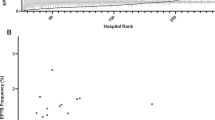Abstract
Objective:
To compare number of US preterm births based on obstetric versus last menstrual period (LMP) estimates and evaluate their correlations with clinical risk indicators associated with prematurity
Study Design:
Preterm births were assessed from LMP, per standard practice, and, separately, from obstetric estimates using the 2012 Natality Public Use File. Percentages of infants with neonatal intensive care unit (NICU) admission and low birth weight (LBW) were calculated.
Result:
More births were <37 weeks gestational age (GA) by reported LMP (11.4%) versus obstetric estimates (9.5%). Among infants preterm by LMP, but born at 37–41 weeks by obstetric estimates, there were 5.7% NICU admission and 7.7% LBW rates versus 25.2% and 35.4%, respectively, of those preterm by obstetric estimates but born 37–41 weeks by LMP assessments.
Conclusion:
Obstetric estimates provide the most clinically relevant estimates of US preterm births. Assessments calculated from LMP alone may overestimate prematurity incidence by ~20%.
This is a preview of subscription content, access via your institution
Access options
Subscribe to this journal
Receive 12 print issues and online access
$259.00 per year
only $21.58 per issue
Buy this article
- Purchase on Springer Link
- Instant access to full article PDF
Prices may be subject to local taxes which are calculated during checkout



Similar content being viewed by others
References
Tucker J, McGuire W . Epidemiology of preterm birth. BMJ 2004; 329 (7467): 675–678.
Talge NM, Holzman C, Wang J, Lucia V, Gardiner J, Breslau N . Late-preterm birth and its association with cognitive and socioemotional outcomes at 6 years of age. Pediatrics 2010; 126 (6): 1124–1131.
User Guide to the 2012 Natality Public Use File. 2013. Available from ftp://ftp.cdc.gov/pub/Health_Statistics/NCHS/Dataset_Documentation/DVS/natality/UserGuide2012.pdf. (cited 19 February 2014).
Births: Final Data for 2011. 2013. Available from http://www.cdc.gov/nchs/data/nvsr/nvsr62/nvsr62_01_tables.pdf. (cited 12 February 2014).
Wier ML, Pearl M, Kharrazi M . Gestational age estimation on United States livebirth certificates: a historical overview. Paediatr Perinat Epidemiol 2007; 21 (Suppl 2): 4–12.
Qin C, Hsia J, Berg CJ . Variation between last-menstrual-period and clinical estimates of gestational age in vital records. Am J Epidemiol 2008; 167 (6): 646–652.
Callaghan WM, Dietz PM . Differences in birth weight for gestational age distributions according to the measures used to assign gestational age. Am J Epidemiol 2010; 171 (7): 826–836.
Dietz PM, England LJ, Callaghan WM, Pearl M, Wier ML, Kharrazi M . A comparison of LMP-based and ultrasound-based estimates of gestational age using linked California livebirth and prenatal screening records. Paediatr Perinat Epidemiol 2007; 21 (Suppl 2): 62–71.
Hall ES, Folger AT, Kelly EA, Kamath-Rayne BD . Evaluation of gestational age estimate method on the calculation of preterm birth rates. Matern Child Health J 2014; 18 (3): 755–762.
Lazariu V, Davis CF, McNutt LA . Comparison of two measures of gestational age among low income births. The potential impact on health studies, New York, 2005. Matern Child Health J 2013; 17 (1): 42–48.
Hediger ML, Kiely JL . Foreward. Paediatr Perinat Epidemiol 2007; 21 (Suppl. 2): 1–3.
American College of Obstetricians and Gynecologists. ACOG Practice Bulletin No. 101: ultrasonography in pregnancy. Obstet Gynecol 2009; 113 (2 Pt 1): 451–461.
Reddy UM, Abuhamad AZ, Levine D, Saade GR . Fetal Imaging Workshop Invited Participants Fetal imaging: executive summary of a joint Eunice Kennedy Shriver National Institute of Child Health and Human Development, Society for Maternal-Fetal Medicine, American Institute of Ultrasound in Medicine, American College of Obstetricians and Gynecologists, American College of Radiology, Society for Pediatric Radiology, and Society of Radiologists in Ultrasound Fetal Imaging Workshop. Obstet Gynecol 2014; 123 (5): 1070–1082.
Guide to completing the facility worksheets for the certificate of live birth and report of fetal death. 2003. Available from http://www.cdc.gov/nchs/data/dvs/guidetocompletefacilitywks.pdf (cited 1 April 2014).
McCabe ER, Carrino GE, Russell RB, Howse JL . Fighting for the next generation: US prematurity in 2030. Pediatrics 2014; 134 (6): 1193–1199.
Acknowledgements
Medical writing assistance was provided by John E. Fincke and Anny Wu of Complete Healthcare Communications, Inc., (Chadds Ford, PA, USA) and funded by MedImmune. This study was sponsored by MedImmune.
Author information
Authors and Affiliations
Corresponding author
Ethics declarations
Competing interests
CSA, HC, CR and GK are employees of AstraZeneca and may have stock or stock options. ECS has no conflict of interest to declare.
Additional information
Supplementary Information accompanies the paper on the Journal of Perinatology website
Supplementary information
Rights and permissions
About this article
Cite this article
Ambrose, C., Caspard, H., Rizzo, C. et al. Standard methods based on last menstrual period dates misclassify and overestimate US preterm births. J Perinatol 35, 411–414 (2015). https://doi.org/10.1038/jp.2015.25
Received:
Revised:
Accepted:
Published:
Issue Date:
DOI: https://doi.org/10.1038/jp.2015.25
This article is cited by
-
Errors in estimated gestational ages reduce the likelihood of health facility deliveries: results from an observational cohort study in Zanzibar
BMC Health Services Research (2020)
-
Adequate antenatal care and ethnicity affect preterm birth in pregnant women living in the tropical rainforest of Suriname
BMC Pregnancy and Childbirth (2020)
-
Modeling the Potential Impact of the 2014 American Academy of Pediatrics Respiratory Syncytial Virus Prophylaxis Guidance on Preterm Infant RSV Outcomes
Infectious Diseases and Therapy (2015)



